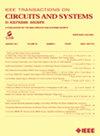含滞后夹层模型的三阶段辨识方法
IF 4.9
2区 工程技术
Q2 ENGINEERING, ELECTRICAL & ELECTRONIC
IEEE Transactions on Circuits and Systems II: Express Briefs
Pub Date : 2025-06-17
DOI:10.1109/TCSII.2025.3580551
引用次数: 0
摘要
本文研究了具有迟滞特性的夹层系统的识别问题。针对前级子系统对输入信号的滤波作用导致滤波后的激励输入导致后续子系统激励不足从而降低识别精度的问题,提出了一种新的鲁棒三级识别方法,保证了整个系统的充分激励,提高了识别精度。该方法的关键在于分阶段估计子系统参数。在每个阶段中,参数估计采用键项分离原理并结合迭代过程进行。然后,基于先前估计的子模型参数,建立逆模型对输入激励信号进行滤波。因此,抵消了前一级子系统对输入信号的滤波作用导致的后一级子系统的激励不足,提高了参数估计的精度。最后,将该方法应用于电磁微镜的参数辨识。本文章由计算机程序翻译,如有差异,请以英文原文为准。
The Three-Stage Identification Method of the Sandwich Model With Hysteresis
This brief investigates the identification of sandwich systems exhibiting hysteresis behavior. To address the problem that the filtering effect of the previous-stage subsystem on the input signal results in the filtered excitation input causing insufficient excitation of the subsequent-stage subsystems, thus reducing the identification accuracy, a new robust three-stage identification method is proposed to ensure the sufficient excitation of the entire system and enhance the identification accuracy. The key to this method lies in the staged estimation of subsystem parameters. In each stage, parameter estimation is carried out using the key-item separation principle combined with an iterative process. Then, based on the previously estimated submodel parameters, an inverse model is developed to filter the input excitation signal. Therefore, the insufficient excitation of the subsequent-stage subsystem caused by the filtering effect of the previous-stage subsystem on the input signal is counteracted, enhancing parameter estimation accuracy. Finally, this method is applied to the parameter identification of an electromagnetic micromirror.
求助全文
通过发布文献求助,成功后即可免费获取论文全文。
去求助
来源期刊
CiteScore
7.90
自引率
20.50%
发文量
883
审稿时长
3.0 months
期刊介绍:
TCAS II publishes brief papers in the field specified by the theory, analysis, design, and practical implementations of circuits, and the application of circuit techniques to systems and to signal processing. Included is the whole spectrum from basic scientific theory to industrial applications. The field of interest covered includes:
Circuits: Analog, Digital and Mixed Signal Circuits and Systems
Nonlinear Circuits and Systems, Integrated Sensors, MEMS and Systems on Chip, Nanoscale Circuits and Systems, Optoelectronic
Circuits and Systems, Power Electronics and Systems
Software for Analog-and-Logic Circuits and Systems
Control aspects of Circuits and Systems.

 求助内容:
求助内容: 应助结果提醒方式:
应助结果提醒方式:


